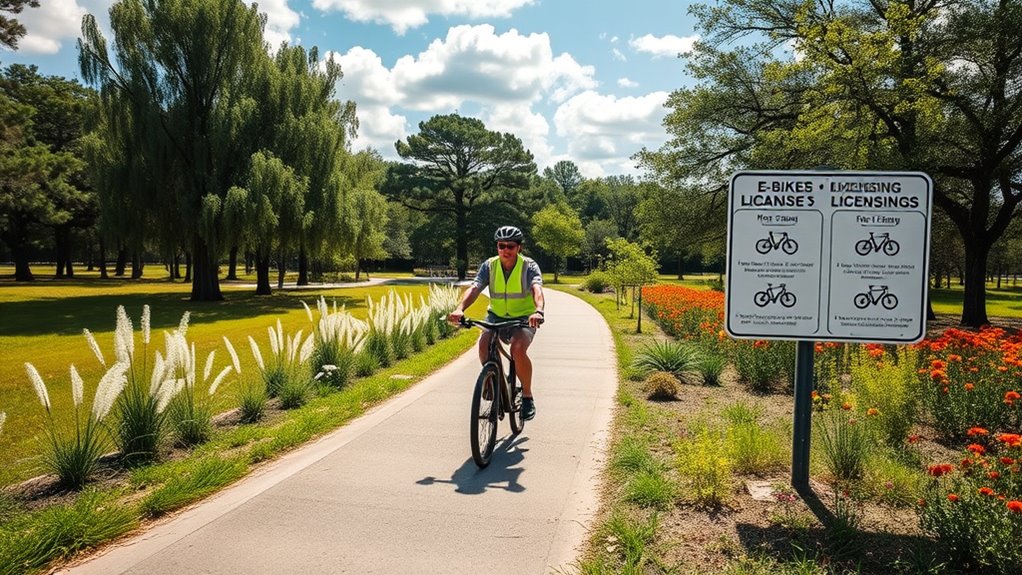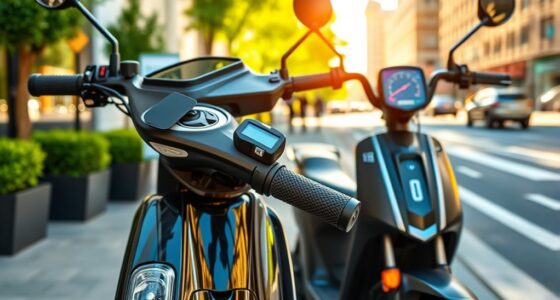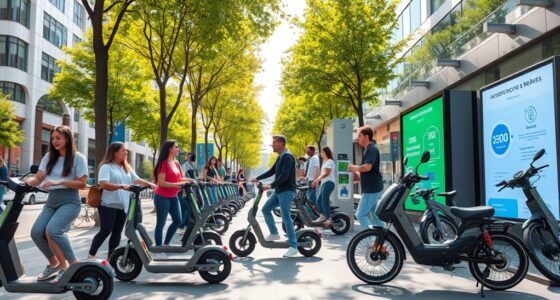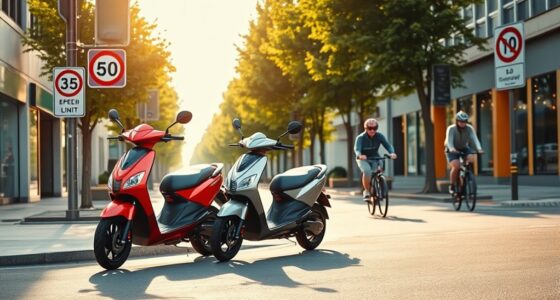In Texas 2025, understanding e-bike rules is key to riding safely and legally. You should know the class distinctions: Class 1 and 3 are pedal-assist up to 20 mph, while Class 2 is throttle-operated. Most e-bikes can be used on streets and bike lanes, but check local restrictions for parks or trails. No special license is typically needed, but staying informed about current regulations is smart. Keep exploring to get all the details and ride with confidence.
Key Takeaways
- Texas classifies e-bikes into three categories: Class 1 and 3 are pedal-assist up to 20 mph; Class 2 is throttle-operated up to 20 mph.
- E-bikes are generally permitted on streets and bike lanes; some parks and trails may restrict motorized vehicles.
- No special license is required for e-bike riders in Texas, but riders under 18 should carry proof of age.
- Riders should wear safety gear and follow local laws to ensure safe, compliant riding.
- Always verify individual park or trail rules regarding e-bike access and restrictions before riding.
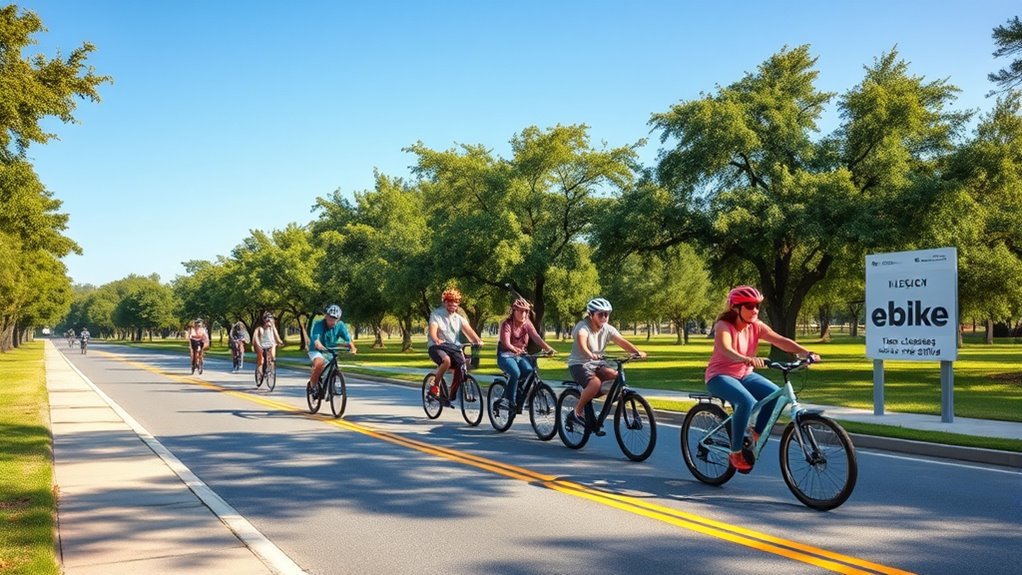
If you’re riding an e-bike in Texas, it’s vital to understand the state’s specific rules to stay safe and compliant. E‑bike safety starts with knowing the different e‑bike classes and the regulations that apply to each. Texas classifies e‑bikes into three categories based on motor power and speed capabilities. Class 1 e‑bikes have pedal-assist only and top out at 20 mph. Class 2 e‑bikes can be throttle-operated up to 20 mph. Class 3 e‑bikes also assist up to 20 mph but often feature speedometers and are limited to pedal assist. Recognizing these distinctions helps you ride within legal limits and avoid penalties.
Rider education plays an essential role in guaranteeing your safety while enjoying your e‑bike. Before hitting the road or trail, you should familiarize yourself with local rules and best practices, such as wearing a helmet, obeying traffic signals, and using lights at night. Many cities and parks require lights and reflectors, so check those requirements before your ride. Texas encourages rider education programs that help new e‑bike users learn safe riding techniques, traffic laws, and how to handle different terrains. Participating in these programs not only boosts your confidence but also promotes responsible riding, which benefits everyone sharing the road or path.
Rider education boosts confidence and promotes safe, responsible e-bike riding in Texas.
Understanding where you can ride your e‑bike is equally important. Texas generally allows e‑bikes on streets and bike lanes, but restrictions may apply in certain parks or trails. For example, some parks prohibit motorized vehicles altogether, so you need to verify the rules for each area you plan to visit. Additionally, some cities have specific ordinances about e‑bike speeds or where they can be parked. Staying informed about these local regulations prevents accidental violations and helps you enjoy your ride without interruptions. Moreover, understanding the contrast ratio of your e‑bike’s display can help you read information clearly under various lighting conditions.
Finally, licensing requirements are straightforward for most e‑bike riders in Texas. You don’t need a special license to operate an e‑bike, but you should carry proof of age if you’re under 18. E‑bike safety isn’t just about protecting yourself; it’s about respecting the rules designed to keep everyone safe on shared paths and streets. Educate yourself regularly about the latest laws, and practice safe riding habits. Doing so ensures you’re not only compliant but also a responsible rider who contributes to the safety and enjoyment of the e‑bike community in Texas.
Frequently Asked Questions
Are E-Bikes Allowed on Sidewalks in Texas?
In Texas, you generally shouldn’t ride your e-bike on sidewalks because it can jeopardize sidewalk safety. Always look for e-bike signage indicating where riding is permitted; some areas might allow it, while others don’t. To stay safe and avoid fines, stick to designated bike paths or roads, especially where sidewalk riding isn’t explicitly allowed. Checking local regulations and signage helps ensure you’re riding responsibly and legally.
Can Minors Legally Operate E-Bikes Without a License?
Think of minors operating e-bikes as young sailors steering their ships; they need proper licensing to navigate safely. In Texas, minors must meet age restrictions to legally operate e-bikes, and they typically don’t need a license if they’re of a certain age. However, for minors, obtaining minor licensing might be required depending on local laws. Always check specific regulations to make sure you’re riding within legal boundaries.
Are E-Bike Helmets Mandatory in Texas?
In Texas, helmet laws make it mandatory for riders under 18 to wear helmets while operating e-bikes. For adults, safety requirements recommend helmet use, but it’s not legally required. Wearing a helmet helps protect you from head injuries and aligns with recommended safety practices. Always prioritize safety by wearing a helmet, especially if you’re under 18, and follow local laws to stay compliant and safe on your e-bike.
How Do E-Bike Laws Differ Between Urban and Rural Areas?
In urban areas, e-bike regulations often require you to follow designated bike lanes and adhere to local speed limits, supported by urban e bike regulations. Conversely, rural e bike infrastructure is less developed, so you might have more freedom but should still ride responsibly. Always check specific local laws, as rural areas may lack clear signage, while cities focus on safety and organized paths for your protection.
What Are Penalties for Violating E-Bike Regulations in Texas?
If you violate Texas e-bike regulations, you could face penalties like fines or even license suspension, depending on the severity of the violation. Enforcement challenges, such as identifying offenders or monitoring e-bike usage, can make penalties less consistent. Penalty severity varies with violations, so always follow local laws to avoid fines or other consequences. Staying informed helps you ride legally and avoid unnecessary penalties.
Conclusion
Guiding Texas’s e-bike rules is like riding a well-marked trail—you’ll enjoy the journey more when you follow the signs. Just last summer, I watched a rider confidently cruise through a designated bike path, knowing he was riding legally and safely. With over 20,000 e-bikes registered in Texas, understanding the rules keeps everyone safe and moving forward. Stick to the guidelines, and your ride will be smooth, just like a seamless trail through scenic Texas landscapes.
